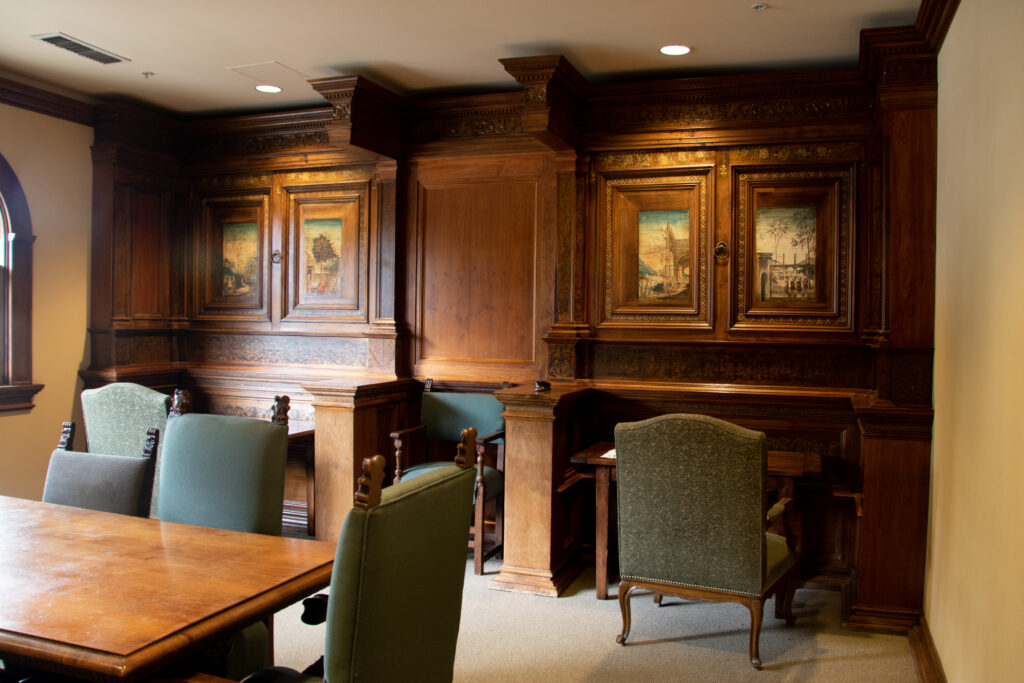Maeve Sanford-Kelly ’26 and Clare Reimers-Hejnal ’26
Staff Writers
Cross-campus dining, innertube water polo, and dwelling over what to wear to Monte Carlo all sound like pieces of a 21st-century Scripps College experience. A long way from the pomp and circumstance of early Scripps, these moments are modern experiences that Scripps students hold dear. But exactly how modern?
When one comes to Scripps, they often hear a lot about the Scripps from the 1920s and 30s with its beautiful buildings and ahead-of-its-time dedication to educating women. But what about the Scrippsies of our parents’ era? Split between traditions from Scripps’ founding and the culture of Scripps today, the Scripps experience of the 1980s and 1990s just might have had the best of both worlds.
Unlike today, where a Scripps student may live in a different dorm every year they are at Scripps, students often lived in the same dorm all 4 years. Residential organizations like Hall Council, a group of five elected officials to govern their respective quarters, created a strong sense of community within each dorm.
Nurturing this sense of community even further, each Scripps dorm had its own dining hall until 2000. During this time, students often ate their meals with the residents of their dorm. Denison Library Librarian Jennifer Martinez Wormser ’95 remembered making friends in the dorm dining hall.
“Especially at breakfast, everyone kind of wandered downstairs in their jammies and got food together,” Wormser said. “So you got to know the people in your dorm really well.”
Each dorm had unique culture and traditions including special events. Clark, then known as Grace Hall, hosted an annual Medieval Holiday Ball for residents where everyone dressed up in medieval gowns and costumes for a grand feast. Beth Rhodehamel ’89 served as the Residential Coordinator for Clark in the late 80s and remembered the costumes and decadence surrounding the annual ball.
“[My senior year, I] dressed up in a Lord of the Manor costume that had been used for decades…and got to pick who my Lady of the Manor was, and she wore equally decorative and historical robes,” Thodehamel recalled. “The Scripps staff dressed up to present the feast on platters as it was paraded in.”
Another Clark tradition was holding the Spring Fling to celebrate the return of warm weather in early spring. “We all went out into one of the courtyards [at Clark] and we had champagne at like 10 in the morning,” Deidre Hughes ’87 said. “We had our breakfast out there. We all brought our chairs and just hung out…and we danced!”
Separate from their individual traditions, dorms would often host parties related to their identity (similar to Harvey Mudd College dorms today). Some of these parties included “Browning Blowout” or “Graceland”. Students from all 5Cs were invited to join.
As a Hall Council Leader for Browning in the early 90s, Wormser had a hand in planning the annual Browning Blowout, which was always a big fundraiser for the dorm because they charged a fee for attendance. “That money went for events or things that you were doing, but it also paid for the alcohol at the next party,” Wormser said.
Scripps students didn’t just party on campus. On Wednesday nights, many of them would go to fraternity parties at Pomona (yes, Pomona had frats!) and mixers between different schools were also very common. One popular party theme was “Screw-Your-Roommate” where students would pair their friends up with people from another school (often Claremont McKenna) for a blind date.
While some party themes, like Monte Carlo, have stayed the same over the years, others like “Pimps and Whores Night” (hosted by CMC in the 80s) have gone by the wasteside.
Just as cross-campus party culture was alive and well, so were cross-campus stereotypes. Pitzer students were often eager to help lead a protest against apartheid in South Africa while many CMC men were bound for careers in finance.
However, some of the stereotypes came with an added tinge of sexism. “Scrippsie,” now a favorite way for Scripps students to define themselves, was seen as derogatory back then.
“[Being called Scrippsies] insinuated that we were lesser in intellectual abilities,” Rhodehamel said. “It went hand in hand with being teased for being there to get our ‘Mrs. Degree.’ It was usually used by insecure types and usually was squelched when they realized we were their classmates and surpassing them academically.”
Throughout the 80s and early 90s, parties at Scripps and across the 5Cs often had an abundance of free-flowing alcohol with little regulation from administration. “I can’t really think of [parties] that didn’t involve alcohol,” Hughes said. “Alcohol was freely available…It was considered private property.”
After a few incidents regarding alcohol in the early-90s, Scripps administration began to crack down on underrage drinking. This included requirements that parties be registered with Campus Safety and that all alcohol be served by certified bartenders only to those of legal drinking age.
“I think once they clamped down with security and bartenders and stuff, that all got much more expensive,” Wormser said. “Maybe that contributed to the demise of the [dorm party culture at Scripps].”
In the years after the new party regulations, Scripps opened Malott Commons as a unified dining hall and Hall Council stopped being a part of student government. These factors may have contributed to the evolution of dorm culture at Scripps and are a part of why many Scripps students today find community outside of their dorm.
Just as with anything else, there are some parts of Scripps that have stayed the same over time and others that have changed dramatically. But perhaps we can learn a thing or two from the traditions and community that the Scripps alumni from the 80s and 90s hold dear.
Image Source: Ellen Hu ’24



